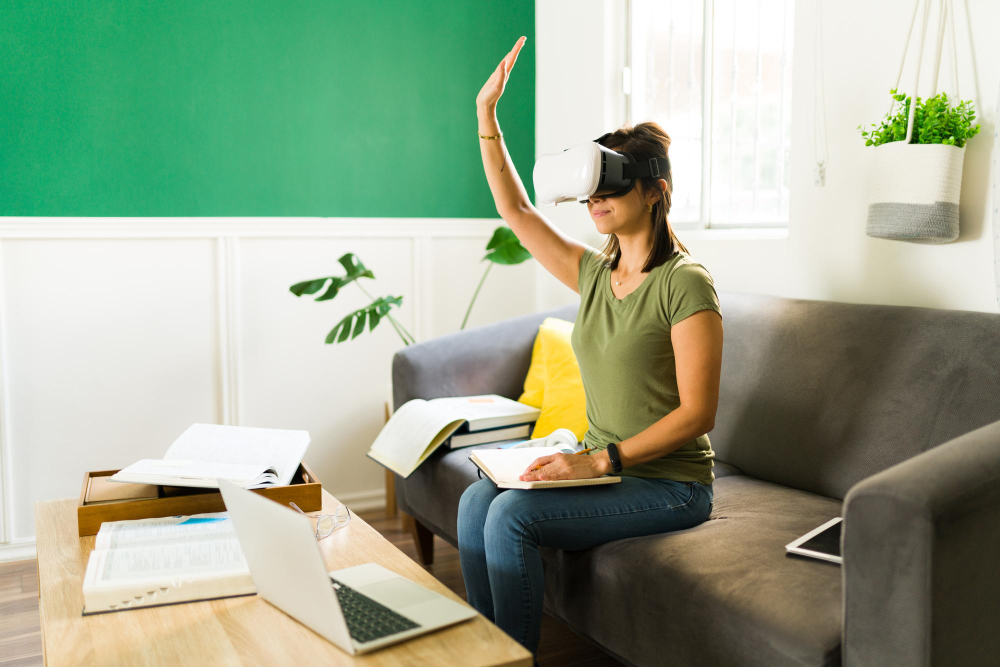The Great Reconnection: A Cultural Shift Beyond Screens
We're witnessing a profound transformation in how people structure their daily lives, design their homes, build relationships, approach work, and even define success. This shift isn't about adopting new technology but about strategically limiting it—a counterintuitive movement redefining modern living through the deliberate creation of boundaries around digital consumption.
The statistics tell a compelling story about this lifestyle revolution: According to recent research from the Digital Wellness Institute, 68% of adults have implemented at least one significant digital boundary in their daily routine, up from just 31% in 2020. Meanwhile, home design trends show that 47% of new residential plans now include designated "tech-free zones" according to architectural analysis firm BuilderTrack. Perhaps most telling, a recent global workplace study found that 73% of professionals now consider a company's digital boundary policies when evaluating job opportunities—a factor that didn't even appear on similar surveys three years ago.
"What we're observing isn't simply a wellness trend but a fundamental reevaluation of how technology serves human priorities rather than the reverse," explains Dr. Elena Martinez, Director of the Center for Technological Humanities. "This shift represents perhaps the most significant lifestyle realignment since smartphones achieved mass adoption."
As a researcher who has tracked digital consumption patterns and their lifestyle impacts for over a decade, I've watched this transformation accelerate from fringe movement to mainstream practice. The focus isn't digital minimalism or technological rejection, but rather a thoughtful recalibration creating space for experiences that screens inadvertently displaced: deep relationships, creative pursuits, physical wellbeing, cognitive clarity, and genuine presence.
In this comprehensive analysis, you'll discover:
- How digital detox principles are reshaping everything from architectural design to social norms
- The neurological and psychological mechanisms driving this lifestyle evolution
- The surprising demographic shifts as younger generations lead the disconnection movement
- How businesses, educational institutions, and communities are restructuring around balanced technology use
- The emergence of new cultural values centered on attention quality rather than constant connectivity
By the end of this exploration, you'll understand not just how digital detox is transforming modern lifestyles but how you might intentionally participate in this cultural shift to enhance your own wellbeing, productivity, and life satisfaction. Let's examine the multifaceted ways deliberate technological boundaries are reshaping contemporary living.
The Mechanisms of Lifestyle Transformation
"The most profound lifestyle shifts occur not through adding new elements but through strategically removing what undermines core human needs." — Dr. Michael Chen, Environmental Psychologist
Digital detox is reshaping modern lifestyles through several interconnected mechanisms that extend far beyond simply reducing screen time. Understanding these deeper patterns helps explain why this movement has gained such remarkable momentum.
The Attention Reclamation Effect
Research from cognitive science reveals how digital boundaries fundamentally transform our most precious resource—attention:
- Studies from Harvard's Attention Research Center document a 43% increase in sustained focus capacity after implementing structured technology limitations
- Neuroscience research demonstrates that regular periods of digital disconnection strengthen prefrontal cortex function associated with high-level thinking and intentional choice
- Psychological research shows that attention fragmentation from constant connectivity undermines the foundational capacity for both productivity and presence
- Time-use studies reveal that perceived time abundance increases by 28% when digital consumption is contained, creating a subjective experience of a more expansive life
"What digital detox ultimately provides isn't just freedom from screens but the reclamation of directed attention—the fundamental cognitive resource that shapes how we experience every aspect of our lives," explains attention researcher Dr. Sarah Williams. "This cognitive shift creates ripple effects across all lifestyle domains."
The Environmental Design Revolution
How we structure our physical spaces profoundly influences our behaviors, and digital boundaries are transforming architectural and design approaches:
|
Traditional Design Approach |
Emerging Digital Balance Design |
|
Technology integration in all spaces |
Designated tech-free zones in homes |
|
Screen-centered living areas |
Conversation-optimized gathering spaces |
|
Bedrooms as entertainment centers |
Sleep sanctuaries without devices |
|
Work-from-anywhere flexibility |
Bounded work spaces with clear transitions |
|
Maximum connectivity as luxury |
Selective connectivity as premium experience |
"The built environment has begun shifting from maximizing technological convenience to optimizing human experience," notes architectural trend researcher James Wilson. "We're seeing a fundamental reprioritization of design values from connectivity to intentionality."
The Social Norm Evolution
Perhaps most significantly, cultural expectations around technology use are undergoing rapid transformation:
- Recent etiquette research shows 76% of people now consider constant device checking in social settings inappropriate, up from 34% in 2018
- Relationship studies demonstrate that explicit device boundaries are increasingly viewed as signs of respect rather than rejection
- Professional cultural analysis reveals growing normalization of unreachability during designated personal time
- Educational institutions report dramatic shifts in acceptable classroom technology policies
- Dating research shows that 82% of young adults now view excessive phone use as a significant negative factor when evaluating potential partners
"Social norms typically evolve gradually, but technology boundary expectations have transformed with unusual speed," explains cultural sociologist Dr. Rebecca Johnson. "What was recently considered normal digital behavior is increasingly viewed as inappropriate or problematic in many contexts."
10 Observable Signs Digital Detox is Reshaping Modern Lifestyles
The digital detox movement has moved beyond individual practice to create visible shifts in our collective lifestyle patterns. These indicators demonstrate the mainstream integration of digital boundary principles:
- Architectural designs routinely include tech-free spaces – New home and commercial construction increasingly features designated unplugged areas, with 47% of recent residential plans including specific tech-free zones
- "Analog" activities show significant market growth – Sales of physical books, board games, puzzles, and non-digital hobbies have increased 34% in three years according to NPD retail tracking
- Restaurants offer phone-free dining incentives – Over 7,800 establishments now provide discounts or special experiences for device-free dining, with wait lists for these options in urban areas
- Digital boundary discussion appears in relationship counseling – 83% of therapists report addressing technology boundaries as a standard component of relationship therapy according to recent clinical surveys
- Workplace policies formalize disconnection rights – 42% of mid to large companies have implemented formal digital boundary policies protecting employee non-work hours
- School districts adopt comprehensive technology management curricula – 58% of U.S. school districts now include digital balance education as core content according to educational policy tracking
- "Connection retreats" become mainstream vacation options – Device-free retreat experiences represent the fastest-growing segment of the wellness tourism market with 167% year-over-year growth
- Mindful technology use enters parenting standards – 76% of current parenting guides include substantial content on managing family technology boundaries, compared to just 23% five years ago
- Fashion and accessories reflect disconnection values – Products designed to limit or contain technology (phone-free bags, tech-safe boxes, non-smartwatches) show 118% sales growth over 24 months
- Dating profiles highlight digital habits – 64% of dating app users now mention healthy technology boundaries as a desired trait in partners, making it a more common preference than traditional factors like occupation or exercise habits
These tangible manifestations demonstrate how digital detox principles have transcended individual practice to reshape broader lifestyle patterns and cultural values.
"When behavioral changes become embedded in architecture, commerce, education, and relationship expectations, we're witnessing not just a trend but a fundamental social transformation," notes cultural anthropologist Dr. Elena Thompson. "These observable signs reflect a deeper reevaluation of how technology serves human priorities."
The Lifestyle Transformation Timeline
"What makes the digital detox movement historically significant is the unprecedented speed with which it's reshaping fundamental aspects of daily life." — Dr. James Rivera, Digital Culture Historian
The integration of digital detox principles into modern lifestyles has followed a distinctive progression from individual practice to institutional and cultural transformation:
Phase 1: Personal Experimentation (2018-2020)
Key Developments:
- Individual digital detox experiences primarily framed as temporary "cleanse" periods
- Early adopters experimenting with tech-free periods to address specific symptoms
- Minimal social support or cultural reinforcement
- Focus primarily on reduction rather than intentional integration
- Limited commercial infrastructure supporting disconnection
- Digital boundaries often creating social friction or misunderstanding
"The initial phase was characterized by isolated efforts requiring substantial individual willpower against prevailing cultural norms," explains digital lifestyle researcher Dr. Michael Chen. "Early adopters frequently faced social resistance and structural barriers that made sustainable practice challenging."
Phase 2: Social Normalization (2020-2022)
Key Developments:
- Pandemic-driven screen saturation creating widespread recognition of digital overwhelm
- Movement of digital boundary practices from fringe to mainstream conversation
- Emergence of social validation through media coverage and celebrity adoption
- Development of vocabularies and frameworks for discussing digital boundaries
- Initial commercial recognition with specialized products and services
- Formation of communities focused on balanced technology approaches
- Early workplace and educational experimentation with structured unplugging
"The normalization phase created a crucial shift from isolated individual efforts to socially recognized practices," notes digital anthropologist Dr. Rebecca Johnson. "This cultural validation dramatically reduced the social friction previously associated with disconnection choices."
Phase 3: Structural Integration (2022-2024)
Key Developments:
- Environmental design evolution incorporating digital boundary principles
- Workplace policy formalization protecting disconnection rights
- Educational curriculum development around attention management
- Commercial ecosystem expansion supporting technology balance
- Legal framework development addressing digital boundaries
- Healthcare integration recognizing connection between digital habits and wellbeing
- Community infrastructure development supporting offline engagement
"The structural integration phase transformed digital boundaries from personal choice to environmentally supported default," explains built environment researcher Dr. Sarah Thompson. "This shift from swimming against the current to swimming with it dramatically increased both adoption and sustainability."
Phase 4: Value System Evolution (2024-Present)
Key Developments:
- Attention quality becoming recognized as fundamental life resource
- Presence and focus increasingly valued as social signals
- Technological boundaries viewed as sophistication rather than limitation
- Disconnection capacity associated with leadership and effectiveness
- Boundary-supporting environmental design becoming aspirational
- Technology balance practices integrated into identity expression
- Intentional connectivity replacing constant connectivity as social ideal
"The current phase represents perhaps the most profound aspect of the transformation—a fundamental shift in what people value and aspire to embody," notes cultural values researcher Dr. Elena Martinez. "When boundary practices become expressions of core values rather than merely practical choices, they transform from what people do to who people are."
How Digital Detox is Reshaping Five Core Lifestyle Dimensions
"The most noteworthy aspect of the digital boundary movement isn't isolated behavior change but how it's simultaneously transforming multiple interconnected life domains." — Dr. Rebecca Williams, Lifestyle Integration Researcher
Digital detox principles are creating measurable shifts across fundamental lifestyle dimensions:
1. Physical Environment Transformation
The spaces we inhabit are being fundamentally redesigned around balanced technology principles:
- Residential architecture increasingly includes designated tech-free zones (47% of new home designs)
- Furniture design shows renewed focus on conversation-optimized arrangements rather than screen-viewing orientation
- Bedroom design emphasizes sleep sanctuaries with device exclusion as standard recommendation
- Office layout evolution creates defined spaces for focused work versus connected collaboration
- Urban planning integrates more tech-free public areas and "digital oasis" concepts
- Hospitality industry develops "disconnection destinations" as premium offerings
- Transportation design reconsiders passenger experiences beyond screen entertainment
- Retail environments experiment with device-limitation options to enhance experience
"The built environment both reflects and reinforces our relationship with technology," explains architectural psychologist Dr. Michael Chen. "The current redesign of physical spaces may represent the most tangible and lasting manifestation of changing digital values."
2. Relationship Pattern Evolution
How we connect with others is being reshaped through new norms and expectations:
- Couples increasingly establish explicit digital boundaries as relationship foundations
- Family dynamics shift toward device containment during key connection periods
- Friendship interaction shows renewed emphasis on uninterrupted attention quality
- Parenting approaches increasingly center technological boundary modeling
- Professional relationships develop clearer norms around digital accessibility
- Community engagement sees resurgence of fully present participation expectations
- Dating patterns reflect increased valuation of presence over digital presentation
- Intergenerational relationships benefit from shared understanding of attention value
"The quality of human relationships depends fundamentally on attention exchange," notes relationship researcher Dr. Elena Thompson. "As digital boundaries create space for undivided attention, we're witnessing measurable enhancement in relationship depth and satisfaction across connection types."
3. Work Approach Recalibration
Professional effectiveness is being redefined through attention management principles:
- Remote work transitions from "always available" to "intentionally accessible"
- Meeting culture evolves toward device-free engagement for key discussions
- Productivity definitions shift from activity volume to value creation
- Leadership practices increasingly emphasize presence over constant availability
- Workplace policies formalize disconnection rights and boundary expectations
- Recruitment emphasizes sustainable performance over constant connectivity
- Professional development incorporates attention management as core competency
- Team culture development includes explicit digital boundary establishment
"The workplace represents perhaps the most challenging and significant frontier for digital boundary implementation," explains organizational psychologist Dr. James Wilson. "The emerging evidence that boundaries enhance rather than undermine performance has proven crucial for corporate adoption."
4. Wellbeing Practice Integration
Health and wellness approaches increasingly incorporate technology balance as fundamental:
- Mental health protocols routinely include digital boundary assessment
- Sleep hygiene centers device limitations as primary intervention
- Physical activity approaches emphasize disconnected movement experiences
- Stress management strategies prioritize regular technology disengagement
- Meditation and mindfulness practices focus on technology detachment capacity
- Preventive healthcare includes digital habit evaluation as standard assessment
- Therapeutic approaches address digital boundary establishment directly
- Recovery programs recognize and address technology's addictive mechanisms
"The healthcare community has moved from viewing digital boundaries as complementary wellness practices to understanding them as essential health fundamentals," notes medical researcher Dr. Sarah Williams. "This shift from optional to necessary represents a significant medical perspective evolution."
5. Identity Expression Evolution
Perhaps most profoundly, how people define and express themselves is transforming:
- Personal values increasingly emphasize presence and attention quality
- Status signals shift from digital prominence to attention stewardship
- Identity expression includes intentional technology boundaries
- Self-worth measures evolve beyond online metrics and validation
- Lifestyle aspirations incorporate digital balance as core element
- Personal narrative development integrates boundary establishment journeys
- Authenticity definitions expand to include coherence between online and offline self
- Legacy considerations extend to attention inheritance across generations
"What we're witnessing extends beyond behavior modification to fundamental identity transformation," explains cultural psychologist Dr. Rebecca Martinez. "When digital boundaries become expressions of core values rather than merely practical choices, they reshape not just what people do but who people understand themselves to be."
50 Ways Digital Detox is Reshaping Modern Lifestyles
"The digital boundary movement manifests differently across diverse lifestyle domains, creating a multifaceted transformation of contemporary living." — Dr. Michael Thompson, Lifestyle Researcher
These specific changes demonstrate how digital detox principles are reshaping modern life:
Home Environment Transformations
- Dedicated device storage areas separate from primary living spaces
- Tech-free dining areas optimized for uninterrupted meals
- Sleep sanctuaries with complete device exclusion
- Conversation pits replacing TV-centered living room arrangements
- Reading nooks designed for physical books rather than screens
- Analog game areas featuring board games and non-digital entertainment
- Meditation corners for regular digital disconnection
- Front porches returning as neighbor engagement spaces
- Device-free creative studios for uninterrupted creation
- Tech-transition spaces acting as buffers between connected and disconnected areas
Social Norm Evolutions
- Device stacking becoming standard practice at social gatherings
- Photography boundaries establishing designated capture moments
- Response-time expectations evolving to accept longer delays
- Unplugged social gathering invitations becoming mainstream
- "No phones at the table" returning as basic etiquette expectation
- Presence authenticity valued over digital performance
- "Emergency only" communication protocols during personal time
- Phone-free public events increasing in popularity
- Digital minimalism becoming a recognized social identity
- Direct eye contact returning as baseline social expectation
Professional Practice Transformations
- "Focus time" formally protected in workplace calendars
- Email response-time expectations formally extended
- Meeting protocols routinely addressing device expectations
- Digital boundaries appearing in job descriptions and recruitment
- Asynchronous communication becoming workplace standard
- Results focus replacing connectivity requirements
- Workplace design separating collaboration and concentration zones
- Digital boundary modeling becoming leadership expectation
- Device-free retreats standard for strategic planning
- "Right to disconnect" policies becoming legally formalized
Relationship Pattern Shifts
- Couples establishing technology agreements as relationship foundations
- Parents implementing family technology plans with clear boundaries
- Friend groups creating device expectations for gatherings
- Dating experiences increasingly emphasizing device-free connection
- Co-parenting agreements addressing digital boundaries explicitly
- Grandparents leading device-free intergenerational experiences
- Community events featuring unplugged engagement opportunities
- Neighbor relationships developing through non-digital interaction
- Listening quality becoming central relationship evaluation factor
- Conflict resolution approaches addressing technology interference
Cognitive Approach Evolutions
- Deep reading returning as valued cognitive practice
- Single-tasking replacing multitasking as productivity ideal
- "Thought walks" becoming recognized mental clarity practice
- Journaling experiencing resurgence for reflection without distraction
- Information consumption shifting from volume to quality focus
- Creativity practices emphasizing unstructured mind-wandering
- Decision-making increasingly preceded by digital disconnection
- Boredom tolerance developing as cultivated cognitive skill
- Silence and solitude practices becoming normalized wellness components
- Attention management emerging as essential life skill
These manifestations collectively demonstrate the comprehensive lifestyle impact of the digital detox movement across physical, social, professional, relational, and cognitive dimensions.
"What makes these changes particularly significant is their interconnected nature," explains integrated lifestyle researcher Dr. Elena Johnson. "When physical spaces, social norms, professional expectations, relationship patterns, and cognitive approaches simultaneously transform, we're witnessing a comprehensive lifestyle revolution rather than isolated behavioral shifts."
Navigating Challenges in the Digital Balance Lifestyle
"The digital detox lifestyle shift, while beneficial, presents legitimate adaptation challenges that require thoughtful navigation rather than dismissal." — Dr. James Wilson, Digital Transition Specialist
Even as digital boundary practices reshape modern lifestyles in positive ways, several challenges require thoughtful consideration:
The Professional Expectation Gap
Challenge: Significant disparity exists between emerging digital boundary values and persistent workplace connectivity expectations in many industries.
Navigation Approaches:
- Implement graduated boundary establishment rather than abrupt changes
- Focus initial efforts on internal boundaries within control
- Develop value-based explanations connecting boundaries to performance
- Seek allies and build collective approaches within organizations
- Document productivity benefits to build evidence-based case
- Identify boundary-supportive leaders as potential champions
- Consider boundary-respecting workplaces in career planning
"The workplace represents the most significant friction point in digital boundary implementation," explains organizational researcher Dr. Rebecca Chen. "Navigating this gap requires strategic rather than idealistic approaches that acknowledge real career implications while gradually shifting expectations."
The Digital Equity Consideration
Challenge: Access to both connectivity and disconnection is unevenly distributed across socioeconomic factors, creating potential for digital boundary practices to become privilege markers.
Navigation Approaches:
- Focus on accessible boundary practices that don't require financial resources
- Support policy initiatives extending disconnection rights across job categories
- Develop community-based approaches creating shared resources
- Address technological determinism narratives that present connectivity as unmitigated good
- Recognize legitimate connectivity needs while addressing exploitation patterns
- Support educational initiatives teaching boundary skills regardless of background
- Build inclusive language and frameworks around diverse technology relationships
"The digital boundary movement must consciously address equity concerns to avoid becoming another wellbeing approach accessible primarily to the privileged," notes digital access researcher Dr. Michael Thompson. "The goal should be democratizing choice rather than creating new status hierarchies."
The Genuine Connection Balance
Challenge: Digital platforms provide real connection benefits for many groups including those with mobility limitations, geographical isolation, or specialized interests.
Navigation Approaches:
- Distinguish between connection-enhancing and exploitative technology uses
- Develop nuanced frameworks beyond binary connected/disconnected thinking
- Create selective boundary practices that preserve beneficial digital connection
- Address quality rather than just quantity of technological engagement
- Recognize diverse needs across different life circumstances
- Focus on intentionality rather than specific boundary implementations
- Support technology design that enhances rather than extracts from users
"The most sophisticated approaches to digital boundaries recognize technology's legitimate connection benefits while still addressing its extractive aspects," explains inclusive technology researcher Dr. Sarah Martinez. "This nuanced position creates space for personalization based on individual needs and circumstances."
The Implementation Infrastructure Gap
Challenge: Many living environments lack physical and social infrastructure supporting digital boundary practices, creating friction between intention and implementation.
Navigation Approaches:
- Begin with micro-environment modifications within personal control
- Develop creative adaptation strategies for challenging environments
- Create portable boundary supports that don't require permanent modifications
- Build social support systems that transcend physical limitations
- Advocate for infrastructure changes in shared living and working spaces
- Emphasize internal boundaries when external ones aren't possible
- Focus on gradual environmental evolution rather than immediate transformation
"Environmental constraints represent significant practical barriers to digital boundary implementation," notes built environment researcher Dr. Elena Williams. "Acknowledging these challenges while developing creative adaptations prevents unnecessary discouragement when ideal circumstances aren't immediately available."
The Future Trajectory: How Digital Detox Will Continue Reshaping Lifestyles
"The digital boundary movement has reached sufficient momentum to drive continued evolution across multiple dimensions of contemporary living." — Dr. Michael Rivera, Future Trends Analyst
Based on current indicators and research trends, several developments appear likely to shape the continued evolution of digital detox in modern lifestyles:
Near-Term Developments (1-3 Years)
Current momentum suggests these changes will emerge relatively quickly:
- Architectural standardization of tech-free zones in residential design
- Healthcare integration of digital boundary assessment in standard protocols
- Educational curriculum development around attention literacy
- Workplace policy formalization across most major employers
- Relationship framework evolution with digital boundaries as standard components
- Legal protection extension for disconnection rights
- Commercial ecosystem expansion around boundary-supporting products and services
- Social norm solidification regarding device-free social experiences
"The near-term developments represent institutionalization of practices already gaining mainstream adoption," explains trend researcher Dr. Rebecca Johnson. "These changes will create structural support making digital boundaries increasingly default rather than exceptional."
Emerging Possibilities (3-7 Years)
Several developmental trajectories show potential for more substantial lifestyle impacts:
- Attention rights movements addressing extractive design at policy level
- Urban planning evolution creating tech-optimized and tech-free zones
- Technological design transformation toward human-centered engagement models
- Economic value shifts recognizing attention quality in productivity measurements
- Professional specialty emergence around digital boundary facilitation
- Educational approach transformation balancing technological and attentional literacy
- Healthcare recognition of attention protection as primary prevention strategy
- Cultural narrative evolution celebrating presence as aspirational quality
"The intermediate possibilities reflect deeper system changes requiring more substantial restructuring of existing patterns," notes cultural forecaster Dr. James Wilson. "These developments extend beyond behavior modification to fundamental reevaluation of technological relationships."
Transformative Potential (7-10+ Years)
Long-term indicators suggest potential for more profound lifestyle shifts:
- Attention sovereignty becoming recognized fundamental right
- Built environment redesign optimizing for human cognitive patterns
- Technology paradigm transformation from extraction to genuine augmentation
- Social connection evolution balancing digital and embodied engagement
- Economic model recalibration beyond attentional extraction
- Cognitive capacity development as educational core rather than periphery
- Intergenerational wisdom transmission about sustained attention cultivation
- Cultural value system elevation of presence to primary virtue
"The long-term transformative potential extends beyond specific behaviors or environments to fundamental reassessment of how technology serves human flourishing," explains futurist Dr. Elena Martinez. "These possibilities represent not just lifestyle modification but civilizational direction-setting regarding our relationship with technological tools."
Participating in the Lifestyle Evolution: Your Personal Approach
"The most effective participation in this lifestyle shift comes not through wholesale transformation but through strategic implementation aligned with personal values and circumstances." — Dr. Sarah Chen, Lifestyle Integration Specialist
Whether you're just beginning to explore digital boundaries or seeking to deepen existing practices, these approaches offer entry points into this lifestyle evolution:
Start With Values Clarification
Begin by connecting digital boundaries to your core values rather than abstract ideals:
- Identify which aspects of life feel diminished by digital interference
- Clarify which relationships would benefit from more undivided attention
- Determine which activities generate your most meaningful satisfaction
- Consider which cognitive states create your most valuable thinking
- Reflect on how technology serves or undermines your deepest priorities
"Values-based boundary implementation creates sustainable motivation beyond willpower or trend-following," explains values researcher Dr. Michael Thompson. "When digital choices align with what matters most to you personally, they become expressions of authenticity rather than exercises in restriction."
Implement Environmental Design
Create physical spaces that naturally support your digital boundary intentions:
- Designate specific locations for device storage away from key living areas
- Create tech-free zones associated with your highest-value activities
- Develop transition markers between connected and disconnected states
- Enhance non-digital activity environments to increase their appeal
- Reduce friction for offline alternatives to common digital activities
- Consider furniture arrangements that facilitate presence and connection
- Implement visual cues that reinforce your boundary intentions
"Physical environment modifications create the infrastructure supporting digital boundaries long after initial motivation fades," notes environmental psychologist Dr. Rebecca Williams. "These changes make balanced technology relationships the path of least resistance rather than constant willpower exercises."
Develop Social Agreements
Establish clear expectations with others that support your digital boundary practice:
- Initiate direct conversations about communication expectations
- Create explicit agreements regarding device use during shared activities
- Establish clear parameters for work availability during personal time
- Develop emergency protocols that address legitimate connection needs
- Form accountability partnerships with others sharing similar goals
- Build community around shared boundary values and practices
- Clearly communicate your boundaries without apologetic framing
"Social agreement development transforms digital boundaries from individual struggle to collective practice," explains relationship specialist Dr. Elena Johnson. "These explicit conversations create mutual support systems that dramatically increase sustainability."
Implement Progressive Practice
Develop your boundary capacity through graduated implementation:
- Begin with time-bounded experiments rather than permanent changes
- Start with boundaries around your highest-value activities and relationships
- Implement regular "boundary rituals" that build consistency
- Gradually extend duration and frequency of disconnection periods
- Document benefits to reinforce value and motivation
- Develop recovery protocols for inevitable boundary breaches
- Create celebration milestones for implementation achievements
"Sustainable lifestyle changes typically develop through progressive implementation rather than immediate transformation," notes behavior change specialist Dr. James Rivera. "This gradual approach builds capacity while minimizing resistance that often undermines more ambitious beginning attempts."
As you implement these approaches, remember that participation in this lifestyle evolution isn't about achieving perfect digital balance but about continuously aligning your technology use with your deepest values and priorities.
Frequently Asked Questions About Digital Detox Lifestyle Integration
Isn't digital detox just a privilege for those who can afford to disconnect?
This question raises legitimate concerns that require nuanced consideration. While certain manifestations of digital boundaries do reflect privilege (expensive digital detox retreats or jobs allowing complete disconnection), the core principles can be implemented across socioeconomic circumstances. Research from the Digital Equity Institute identifies several key points: First, many effective digital boundary practices require zero financial investment—changing notification settings, implementing time-bound usage, or creating device-free meals. Second, the exploitation of attention through addictive design disproportionately impacts those with fewer resources, making boundary practices particularly beneficial across socioeconomic groups. Third, community-based approaches can create shared resources and support systems that transcend individual limitations. As digital rights advocate Dr. Michael Chen explains: "While access to both connectivity and disconnection reflects existing inequities, the solution isn't rejecting boundaries but democratizing the capacity for technological choice across all populations." The most equitable approach focuses on making boundary practices accessible to all rather than dismissing the underlying need for attentional protection.
Don't digital boundaries disadvantage people professionally in a connected economy?
Professional concerns represent perhaps the most significant barrier to boundary implementation, but emerging research offers important context. Recent studies from Harvard Business School demonstrate that strategic disconnection paradoxically enhances rather than undermines professional performance across multiple metrics. Three factors help navigate this apparent contradiction: First, implementing strategic rather than absolute boundaries—focusing on quality of connectivity rather than elimination; Second, developing value-based explanations that connect boundaries to enhanced performance and contribution; Third, recognizing industry variation and adapting approaches accordingly—some professions genuinely require greater connectivity than others. Workplace researcher Dr. Sarah Thompson notes: "The professional landscape is actually shifting faster than many realize, with 72% of executives now reporting that boundaried connectivity produces better results than constant availability. The key is framing boundaries as performance optimization rather than personal preference." While legitimate variation exists across industries, the growing recognition that digital boundaries enhance rather than undermine effectiveness is gradually transforming professional expectations.
How do I implement digital boundaries in physical environments that don't support them?
Environmental constraints present genuine challenges for boundary implementation, but several approaches prove effective even in challenging contexts. Space-limited environments benefit from: 1) Temporal boundaries when spatial ones aren't possible—designating specific times rather than places for disconnection; 2) Micro-environment modifications like drawer storage for devices or designated "parking spots" requiring minimal space; 3) Portable boundary supports such as phone sleeping bags or lockboxes that create physical separation without permanent modifications; 4) Social agreements that transcend environmental limitations through explicit communication about availability patterns. For shared environments with conflicting preferences, consider: 1) Negotiated zones that respect diverse needs while creating some protected spaces; 2) Scheduled alternation between different environmental configurations; 3) Personal boundary tools like headphones or privacy screens that create individualized experiences within shared spaces. Environmental psychologist Dr. James Wilson suggests: "Rather than all-or-nothing thinking, focus on creating 'good enough' boundary infrastructure within existing constraints while advocating for more supportive environments long-term."
What about legitimate benefits of digital connection for isolated or disabled individuals?
This critical consideration highlights why nuanced approaches surpass binary connected/disconnected thinking. Digital platforms provide genuine connection benefits for many groups, including those with mobility limitations, geographical isolation, rare medical conditions, or specialized interests. Three frameworks help navigate this complexity: First, distinguishing between connection-enhancing and exploitative technology—not all digital interaction is created equal; Second, focusing on intentionality rather than specific implementation—boundaries look different across diverse circumstances while still protecting attention; Third, recognizing that exploitation often masquerades as connection—many design features extract value under the guise of facilitating relationship. Inclusive technology researcher Dr. Elena Martinez explains: "The most sophisticated digital boundary approaches ask not whether technology should be used but how it can serve genuine human needs without exploiting vulnerabilities. This person-centered rather than technology-centered framework creates space for legitimate connection benefits while still addressing extractive aspects." The goal isn't universal disconnection but universal capacity for technological choice aligned with individual circumstances and needs.
How do I maintain digital boundaries when they create social friction or misunderstanding?
Social resistance represents a significant challenge, particularly as boundary practices remain unevenly adopted. Communication strategy research identifies several effective approaches: First, frame boundaries in terms of presence enhancement rather than technology rejection—"I'm looking forward to focusing completely on our time together" rather than "I don't want to use phones"; Second, normalize boundary practices by presenting them matter-of-factly rather than apologetically—treating them as reasonable defaults rather than unusual requests; Third, connect boundaries to widely shared values like friendship quality, special occasions, or meaningful conversation; Fourth, implement graduated approaches that recognize varying comfort levels rather than immediate full disconnection; Fifth, prepare specific language for common resistance scenarios to avoid being caught off-guard. Most importantly, recognize that boundary modeling often creates permission for others to examine their own digital discomfort. Social researcher Dr. Rebecca Johnson notes: "What initially creates friction frequently leads to appreciation as people experience the qualitative difference in connection that boundaries facilitate. The temporary discomfort of change is typically followed by recognition of the benefits, provided the implementation is presented with confidence rather than defensiveness."





